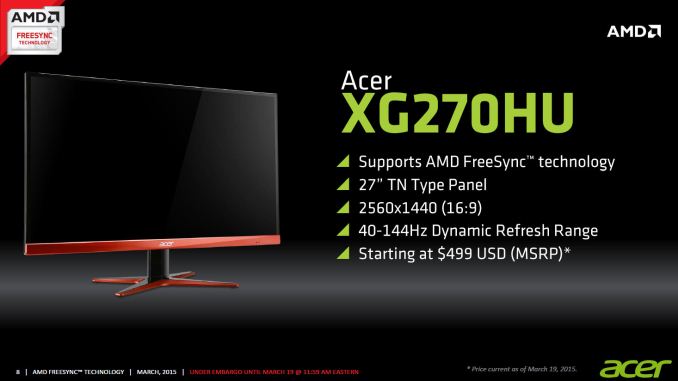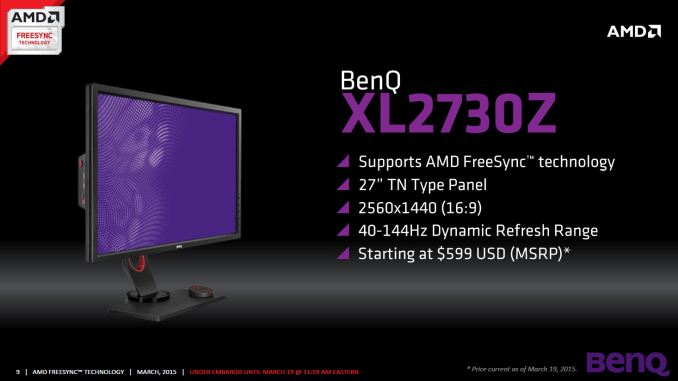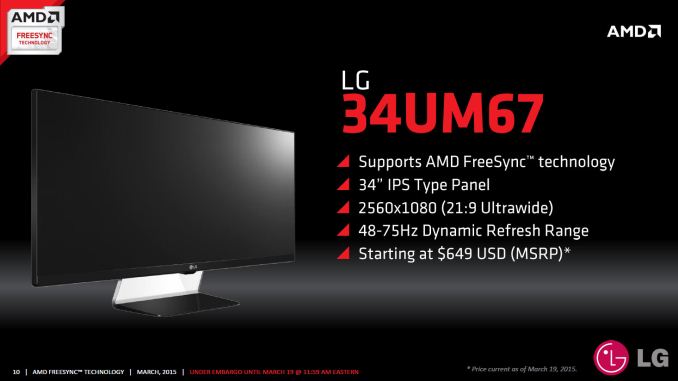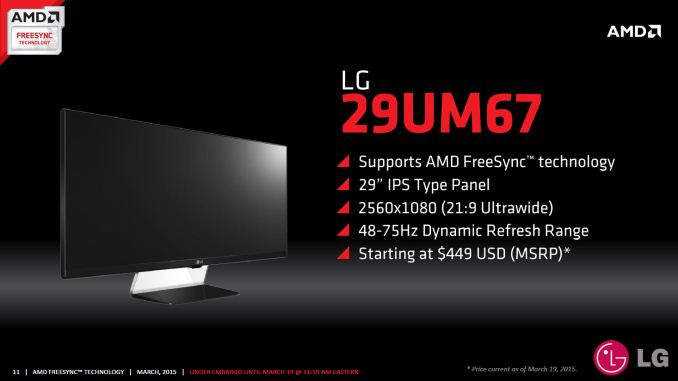The AMD FreeSync Review
by Jarred Walton on March 19, 2015 12:00 PM ESTFreeSync Displays
There are four FreeSync displays launching today, one each from Acer and BenQ, and two from LG. Besides the displays launching today, seven additional displays should show up in the coming weeks (months?). Here’s the current list of FreeSync compatible displays, with pricing where it has been disclosed.
| FreeSync Compatible Displays | ||||||
| Manufacturer | Model | Diagonal | Resolution | Refresh | Panel | Price |
| Acer | XG270HU | 27" | 2560x1440 | 40-144Hz | TN | $499 |
| BenQ | XL2730Z | 27" | 2560x1440 | 40-144Hz | TN | $599 |
| LG Electronics | 34UM67 | 34" | 2560x1080 | 48-75Hz | IPS | $649 |
| LG Electronics | 29UM67 | 29" | 2560x1080 | 48-75Hz | IPS | $449 |
| Nixeus | NX-VUE24 | 24" | 1920x1080 | 144Hz | TN | ? |
| Samsung | UE590 | 28" | 3840x2160 | 60Hz | TN | ? |
| Samsung | UE590 | 23.6" | 3840x2160 | 60Hz | TN | ? |
| Samsung | UE850 | 31.5" | 3840x2160 | 60Hz | TN? | ? |
| Samsung | UE850 | 28" | 3840x2160 | 60Hz | TN? | ? |
| Samsung | UE850 | 23.6" | 3840x2160 | 60Hz | TN? | ? |
| Viewsonic | VX2701mh | 27" | 1920x1080 | 144Hz | TN | ? |
The four displays launching today cover two primary options. For those that want higher refresh rates, Acer and BenQ have TN-based 40-144Hz displays. Both are 27” WQHD displays, so it’s quite probable that they’re using the same panel, perhaps even the same panel that we’ve seen in the ASUS ROG Swift. The two LG displays meanwhile venture out into new territory as far as adaptive refresh rates are concerned. LG has both a smaller 29” and a larger 34” 2560x1080 (UW-UXGA) display, and both sport IPS panels (technically AU Optronics' AHVA, but it's basically the same as IPS).
The other upcoming displays all appear to be using TN panels, though it's possible Samsung might offer PLS. The UE590 appears to be TN for certain, with 170/160 degree viewing angles according to DigitalTrends. The UE850 on the other hand is targeted more at imaging professionals, so PLS might be present; we'll update if we can get any confirmation of panel type.
One of the big benefits with FreeSync is going to be support for multiple video inputs – the G-SYNC displays so far are all limited to a single DisplayPort connection. The LG displays come with DisplayPort, HDMI, and DVI-D inputs (along with audio in/out), and the Acer is similarly equipped. Neither one has any USB ports, though the BenQ does have a built-in USB hub with ports on the side.
Our testing was conducted on the 34UM67, and let me just say that it’s quite the sight sitting on my desk. I’ve been bouncing between the ASUS ROG Swift and Acer XB280HK for the past several months, and both displays have their pros and cons. I like the high resolution of the Acer at times, but I have to admit that my aging eyes often struggle when running it at 4K and I have to resort to DPI scaling (which introduces other problems). The ASUS on the other hand is great with its high refresh rates, and the resolution is more readable without scaling. The big problem with both displays is that they’re TN panels, and having come from using a 30” IPS display for the past eight years that’s a pretty painful compromise.
Plopping the relatively gigantic 34UM67 on my desk is in many ways like seeing a good friend again after a long hiatus. “Dear IPS (AHVA), I’ve missed having you on my desktop. Please don’t leave me again!” For the old and decrepit folks like me, dropping to 2560x1080 on a 34” display also means reading text at 100% zoom is not a problem. But when you’re only a couple feet away, the relatively low DPI does make the pixels much more visible to the naked eye. It even has built-in speakers (though they’re not going to compete with any standalone speakers in terms of audio quality).
The launch price of $649 is pretty impressive; we’ve looked at a few other 21:9 displays in the past, and while the resolution doesn’t match LG’s 34UM95, the price is actually $50 less than the LG 34UM65’s original $699 MSRP (though it’s now being sold at $599). So at most, it looks like putting in the new technology to make a FreeSync display costs $50, and probably less than that. Anyway, we’ll have a full review of the LG 34UM67 in the coming weeks, but for now let’s return to the FreeSync discussion.
Pricing vs. G-SYNC
It certainly appears that AMD and their partners are serious about pricing FreeSync aggressively, though there aren’t direct comparisons available for some of the models. The least expensive FreeSync displays start at just $449, which matches the least expensive G-SYNC display (AOC G2460PG) on price but with generally better specs (29” 2560x1080 and IPS at 75Hz vs. 24” 1920x1080 TN at 144Hz). Looking at direct comparisons, the Acer XG270HU and BenQ XL2730Z are WQHD 144Hz panels, which pits them against the $759 ASUS ROG Swift that we recently reviewed, giving FreeSync a $160 to $260 advantage. As AMD puts it, that’s almost enough for another GPU (depending on which Radeon you’re using, of course).
Based on pricing alone, FreeSync looks poised to give G-SYNC some much needed competition. And it’s not just about the price, as there are other advantages to FreeSync that we’ll cover more on the next page. But for a moment let’s focus just on the AMD FreeSync vs. NVIDIA G-SYNC ecosystems.
Right now NVIDIA enjoys a performance advantage over AMD in terms of GPUs, and along with that they currently carry a price premium, particularly at the high end. While the R9 290X and GTX 970 are pretty evenly matched, the GTX 980 tends to lead by a decent amount in most games. Any users willing to spend $200 extra per GPU to buy a GTX 980 instead of an R9 290X might also be willing to pay $200 more for a G-SYNC compatible display. After all, it’s the only game in town for NVIDIA users right now.
AMD and other companies can support FreeSync, but until – unless! – NVIDIA supports the standard, users will be forced to choose between AMD + FreeSync or NVIDIA + G-SYNC. That’s unfortunate for any users that routinely switch between AMD and NVIDIA GPUs, though the number of people outside of hardware reviewers that regularly go back and forth is miniscule. Ideally we’d see one standard win out and the other fade away (i.e. Betamax, HD-DVD, etc.), but with a one year lead and plenty of money invested it’s unlikely NVIDIA will abandon G-SYNC any time soon.
Prices meanwhile are bound to change, as up to now there has been no competition for NVIDIA’s G-SYNC monitors. With FreeSync finally available, we expect prices for G-SYNC displays will start to come down, and in fact we’re already seeing $40-$125 off the original MSRP for most of the G-SYNC displays. Will that be enough to keep NVIDIA’s proprietary G-SYNC technology viable? Most likely, as both FreeSync and G-SYNC are gamer focused more than anything; if a gamer prefers NVIDIA, FreeSync isn’t likely to get them to switch sides. But if you don’t have any GPU preference, you’re in the market for a new gaming PC, and you’re planning on buying a new monitor to go with it, R9 290X + FreeSync could save a couple hundred dollars compared to GTX 970 + G-SYNC.
There's something else to consider with the above list of monitors as well: four currently shipping FreeSync displays exist on the official day of launch, and Samsung alone has five more FreeSync displays scheduled for release in the near future. Eleven FreeSync displays in the near term might not seem like a huge deal, but compare that with G-SYNC: even with a one year lead (more or less), NVIDIA currently only lists six displays with G-SYNC support, and the upcoming Acer XB270HU makes for seven. AMD also claims there will be 20 FreeSync compatible displays shipping by the end of the year. In terms of numbers, then, DP Adaptive Sync (and by extension FreeSync) look to be winning this war.


























350 Comments
View All Comments
junky77 - Thursday, March 19, 2015 - link
Girls, what about laptops..medi03 - Thursday, March 19, 2015 - link
It's lovely how the first page of the article about FreeSync talks exclusively about nVidia.JarredWalton - Thursday, March 19, 2015 - link
It's background information that's highly pertinent, and if "the first page" means "the first 4 paragraphs" then you're right... but the last two talk mostly about FreeSync.Oxford Guy - Thursday, March 19, 2015 - link
I love how the pricing page doesn't anything to address a big problem with both FreeSync and G-Sync -- the assumption that people want to replace the monitors they already have or have money to throw away to do so.I bought an $800 BenQ BL3200PT 32" 1440 A-MVA panel and I am NOT going to just buy another monitor in order to get the latest thing graphics card companies have dreamt up.
Companies need to step up and offer consumers the ability to send in their panels for modification. Why haven't you even thought of that and mentioned it in your article? You guys, like the rest of the tech industry, just blithely support planned obsolescence at a ridiculous speed -- like with the way Intel never even bothered to update the firmware on the G1 ssd to give it TRIM support.
People have spent even more money than I did on high-quality monitors -- and very recently. It's frankly a disservice to the tech community to neglect to place even the slightest pressure on these companies to do more than tell people to buy new monitors to get basic features like this.
You guys need to start advocating for the consumer not just the tech companies that send you stuff.
JarredWalton - Thursday, March 19, 2015 - link
While we're at it: Why don't companies allow you to send in your old car to have it upgraded with a faster engine? Why can't I send in my five year old HDTV to have it turned into a Smart TV? I have some appliances that are getting old as well; I need Kenmore to let me bring in my refrigerator to have it upgraded as well, at a fraction of the cost of a new one!But seriously, modifying monitors is hardly a trivial affair and the only computer tech that allows upgrades without replacing the old part is... well, nothing. You want a faster CPU? Sure, you can upgrade, but the old one is now "useless". I guess you can add more RAM if you have empty slots, or more storage, or an add-in board for USB 3.1 or similar...on a desktop at least. The fact is you buy technology for what it currently offers, not for what it might offer in the future.
If you have a display you're happy with, don't worry about it -- wait a few years and then upgrade when it's time to do so.
Oxford Guy - Friday, March 20, 2015 - link
"Old" as in products still being sold today. Sure, bud.Oxford Guy - Friday, March 20, 2015 - link
Apple offered a free upgrade for Lisa 1 buyers to the Lisa 2 that included replacement internal floppy drives and a new fascia. Those sorts of facts, though, are likely to escape your attention because it's easier to just stick with the typical mindset the manufacturers, and tech sites, love to endorse blithely --- fill the landfills as quickly as possible with unnecessary "upgrade" purchases.Oxford Guy - Friday, March 20, 2015 - link
Macs also used to be able to have their motherboards replaced to upgrade them to a more current unit. "The only computer tech that allows upgrades without replacing the old part is... well, nothing." And whose mindset is responsible for that trend? Hmm? Once upon a time people could actually upgrade their equipment for a fee.Oxford Guy - Friday, March 20, 2015 - link
The silence about my example of the G1 ssd's firmware is also deafening. I'm sure it would have taken tremendous resources on Intel's part to offer a firmware patch!JarredWalton - Friday, March 20, 2015 - link
The G1 question is this: *could* Intel have fixed it via a firmware update? Maybe, or maybe Intel looked into it and found that the controller in the G1 simply wasn't designed to support TRIM, as TRIM didn't exist when the G1 was created. But "you're sure" it was just a bit of effort away, and since you were working at Intel's Client SSD department...oh, wait, you weren't. Given they doubled the DRAM from 16MB to 32MB and switched controller part numbers, it's probable that G1 *couldn't* be properly upgraded to support TRIM:http://www.anandtech.com/show/2808/2
So if that's the case, it's sounds a lot like Adaptive Sync -- the standard didn't exist when many current displays were created, and it can't simply be "patched in". Now you want existing displays that are already assembled to be pulled apart and upgraded. That would likely cost more money than just selling the displays at a discount, as they weren't designed to be easily disassembled and upgraded.
The reality of tech is that creating a product that can be upgraded costs time and resources, and when people try upgrading and mess up it ends up bringing in even more support calls and problems. So on everything smaller than a desktop, we've pretty much lost the ability to upgrade components -- at least in a reasonable and easy fashion.
Is it possible to make an upgradeable display? I suppose so, but what standards do you support to ensure future upgrades? Oh, you can't foresee the future so you have to make a modular display. Then you might have the option to swap out the scaler hardware, LCD panel, maybe even the power brick! And you also have a clunkier looking device because users need to be able to get inside to perform the upgrades.